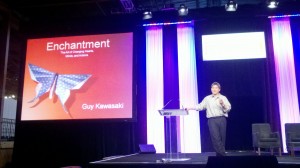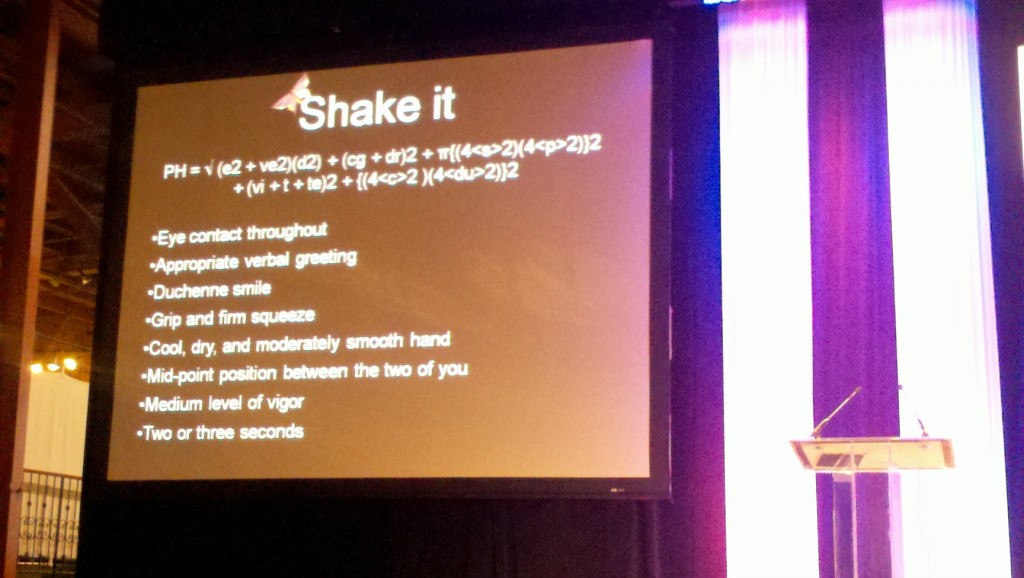enchanting guy kawasaki
I never tire of hearing Guy Kawasaki speak, so his recent address at the NRF’s INNOVATE 2011 Conference was a delight to attend.

He demonstrated a spirit of service and humility as he offered the audience the option of hearing a couple different presentations — and then indulged our urgings and delivered both of them with gusto!
Guy speaks with a passion and authenticity that few professional speakers do – and he keeps his audiences laughing as he offers wise insights about business, marketing, and life. In a word, he enchants his audience, and so he’s the perfect author for a book with Enchantment: The Art of Changing Hearts, Minds, and Actions as its title.
Here are the 10 points Guy highlighted from his book:
1. achieve likability
“No one has ever enchanted someone who wasn’t likable.”
To become likable:
- Use a genuine smile – French physician Guillaume Duchenne identified two distinct types of smiles. A smile which in which you contract both the zygomatic major muscle (which raises the corners of your mouth) and the orbicularis oculi muscle (which raises the cheeks and forms “crow’s feet” around your eyes), and a smile which involves only the zygomatic major muscle. Many researchers believe the former, which they dubbed the “Duchenne smile,” indicates genuine emotion since most people can’t voluntarily contract the orbicularis oculi muscle. (Guy definitely practices what he preaches!)
- Dress for a “tie” with the people you’re meeting (aka “equal dressing”). (Love that Guy, a titan of an industry ruled by CEOs in hoodies and Chuck Taylors, preached about dressing appropriately for your audience!)
- Shake it – check out this “formula” for the perfect handshake:
2. be trustworthy
Trust is a sequence; it’s not a chicken or egg thing. Trust others before they trust you. It’s no surprise some of the most loved companies — Amazon, Zappos, Nordstrom – have generous return policies – they trust their customers. Life is not a zero sum game. Default to a “yes” attitude – think: how can I help others?
3. get ready
Do something; create something great.
Follow the “D.I.C.E.E.” acronym of great products:
- Great products are deep – they have lots of features – e.g., Reef sandal with a bottle opener built in.
- Great products are intelligent – e.g., the Panasonic flashlight which can run on 3 types of batteries, the Ford “my key” feature which enables users to program the maximum speed for a car (useful for parents of teenagers!)
- Great products are complete – they are created for the totality of the user experience – think service, support, etc.
- Great products are elegant – they have an elegant user interface and brand messaging that’s short, sweet and swallow-able.
- Great products are empowering – they enable people to be more productive, more creative.
Also, conduct premortems. Postmortems are conducted too late – everyone’s emotional, people are scattered. Instead, before shipping your product, spend time predicting all the possible reasons it could fail and then eliminate those reasons.
4. launch
Tell a story (nuff said).
Plant many seeds. With old fashioned marketing, you used to have to suck up to a select few oracles whose pronouncement on your product dictated its success or failure. With new marketing, you don’t know who is going to make your product successful so you have to plant many seeds. Guy sent his Enchantment book to 1500 bloggers including Betty, the Beauty Blogger, because you never know…
Use salient points. Talk about the things people care about. For example, instead of promoting how many gigabytes a music player has, talk about the number of songs you can load on it.
5. overcome resistance
The more innovative your product, the more resistance you have to overcome. Here’s how:
- provide social proof — e.g., the white cords of headphones drove the success of Apple’s iPod because people could see “proof” that you owned a cool product.
- find a bright spot — e.g., Jerry Sternin went to Vietnam to address malnutrition. By examining the children who were larger and healthier than most, he discovered important differences in their eating habits and diet. So he helped spread the ways the better-nourished families cooked and ate, and achieved great success in the fight against malnutrition.
- enchant all the influencers – e.g., at the premiere of his movie, Justin Bieber’s manager went out into the parking lot and gave tickets to a few fans. The good will this gesture generated was golden. (see Guy’s post on American Express’s OPEN Forum about “What We Can Learn from Justin Bieber” )
6. endure
Evolve – e.g., While other musicians try in vain to prevent piracy, The Grateful Dead actually sets aside place at their concerts for people who want to record them. (Leave it to a 50-year old band to demonstrate the importance of adaptability!)
Invoke reciprocation. It’s not about using money, it’s about relationships. When you do something for someone and they thank you, be sure to respond with “I know you would do the same for me.” This tells them you’re an honorable person – and it, and sets them up to pay you back some day.
Build an ecosystem. To promote and distribute his book, Guy is creating an ecosystem of user groups, blogs, resellers, etc.
7. present
(Guy’s well-known advice for killer presentations):
- Pitches should follow the 10/20/30 rule — 10 slides, 20 minutes, 30 point font size.
- Customize the introduction for your audience.
- Sell your dream.
8. use technology
Technology should be used to provide information, insights, and assistance. Be aware of technology speed bumps (features like Captcha which frustrate the user and make it difficult to communicate with you.)
And use technology to engage “fast, many, often” – fast: within 24-48 hours; many: with a lot of people; often: with frequency. In today’s business environment, social media is core, not context. Use it.
9. enchant up
How to enchant the people you work for:
- Drop everything at once – your boss is your customer. (Again, a refreshing contrast to the prevailing entitlement mentality of many from the digital generation, doncha think?!)
- Prototype fast – “don’t worry, be crappy.” It’s OK to ship first, then test.
- Deliver bad news early — never let a problem become a surprise – just tell your boss what happened and then tell her what you’re going to do to fix it.
10. enchant down
How to enchant people who work for you:
Give them what they really want – M.A.P.:
- mastery — show them how you are increasing their skill set
- autonomy – give them freedom
- purpose – connect what they’re doing to a greater cause
Suck it up — be willing to do the dirty work. Never ask someone to do something you wouldn’t do yourself.
Involve them. Guy crowdsourced the image on the cover of his book, and got a butterfly named after himself in the process. He closed his talk by proudly showing off the “Kawasaki Swallowtale!”
related posts:

